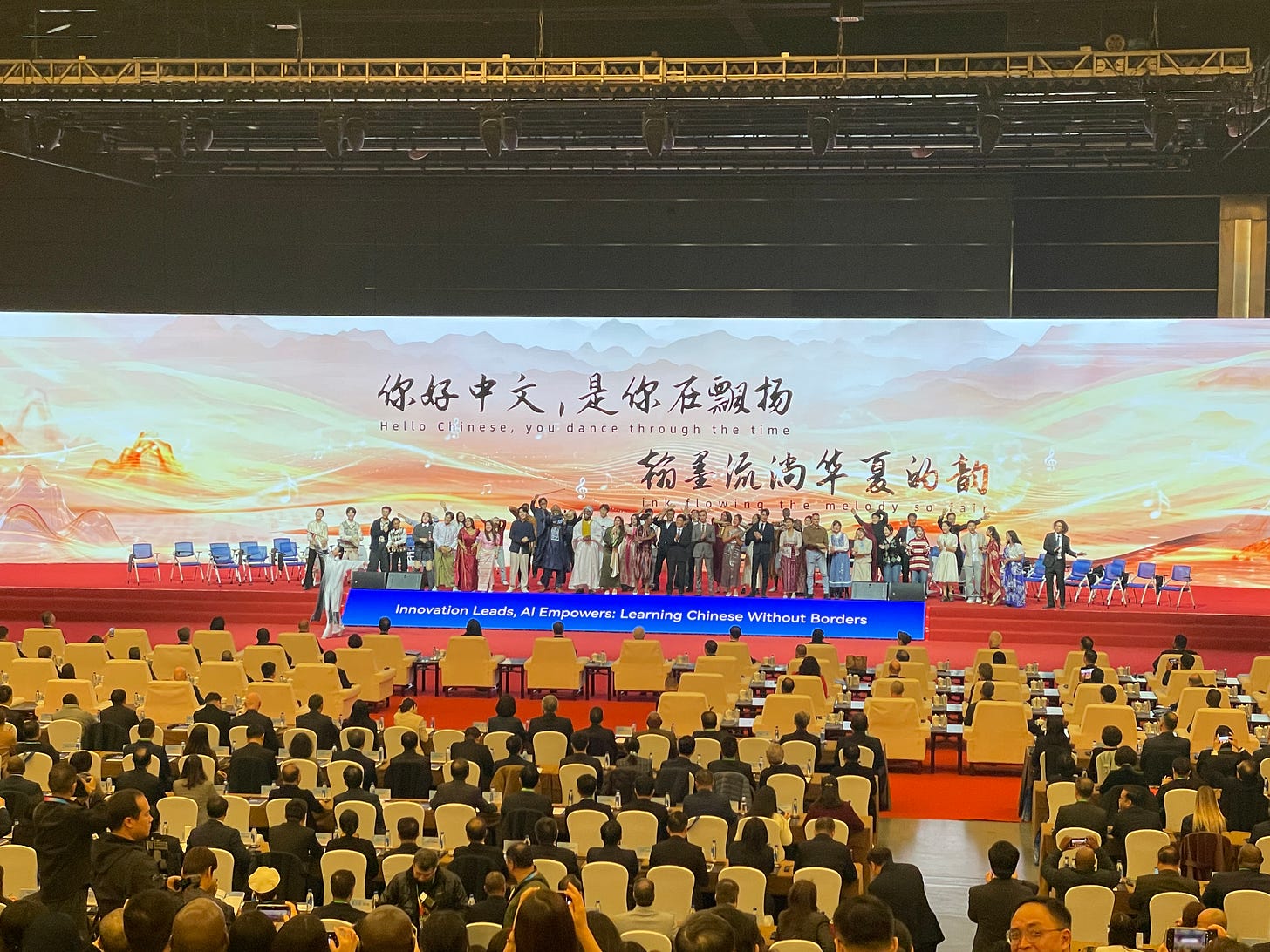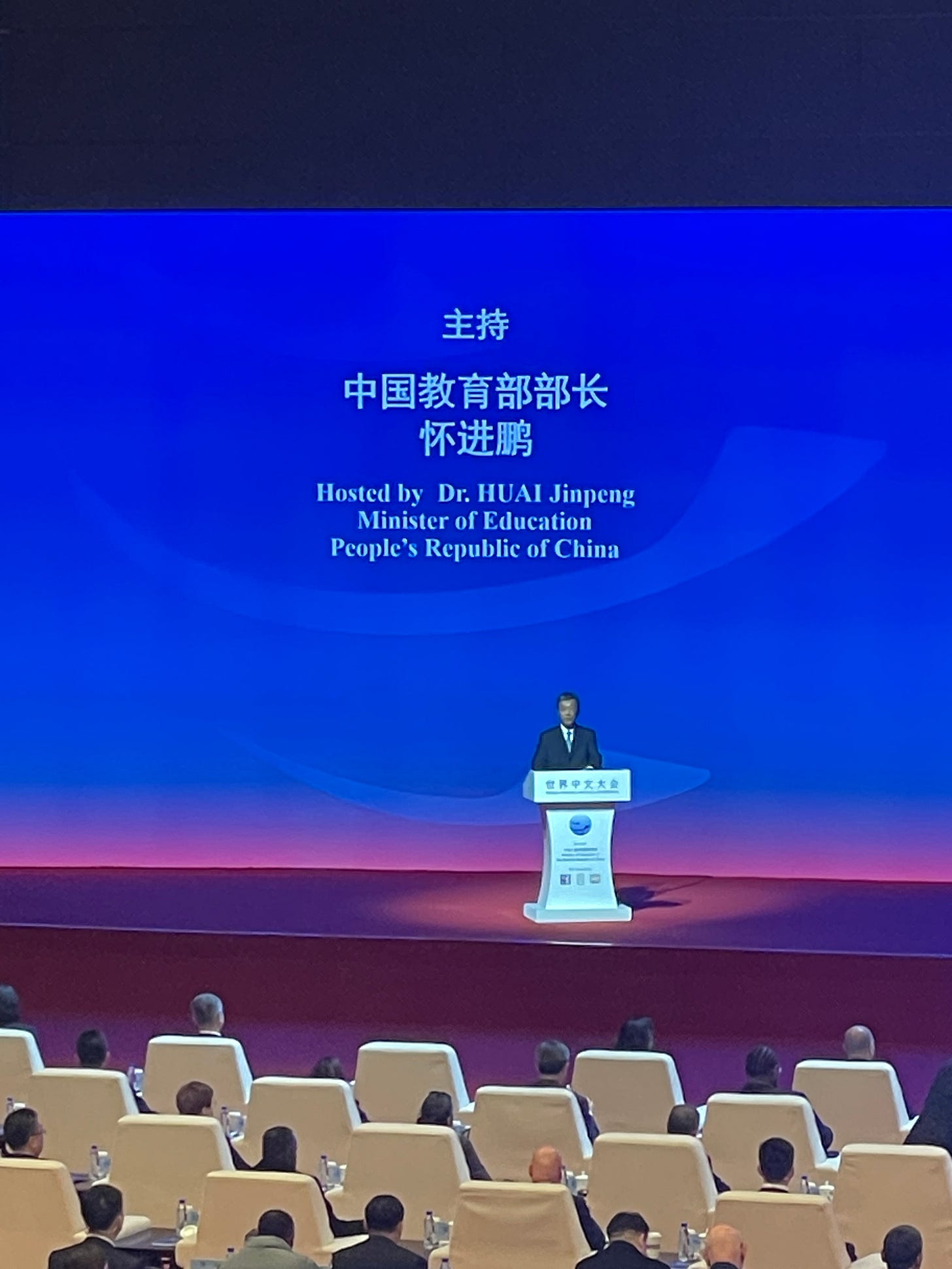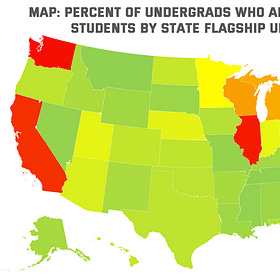China Will Gladly Take Our International Students, Bad Gen Z Survey, & More
Around the College Towns: Links and commentary related to urbanism and higher ed for the week of -
Note: Around the College Towns is my weekly links roundup article on urbanism and education. These posts mostly cover news that may have fallen through the cracks rather than the big events.
US Lost, China Found in Global Higher Ed
You may have noticed that this edition of Around the College Towns was a couple of days late. Sorry about that. I have been trying to catch up on work (and sleep) since returning from a breakneck trip to Beijing for three days.
I went to China for the World Chinese Language Conference. Apparently, the event brought in 5,000 visitors from across the world under the theme “Innovation Leads, AI Empowers: Learning Chinese Without Borders.” There were some fairly big dignitaries there, too, such as China’s Minister of Education.
I was with a group of foreign scholars and doctoral students, all of whom had done their studies/ research in China funded through the former Hanban (Centre for Language Education and Cooperation). You may know them better as the Confucius Institutes.
Yes, the controversial Confucius Institutes have all but closed in the US (or much of the West) due to concerns over espionage and Chinese government interference, but they are still alive and well in other parts of the world. Everyone in my group of roughly 20 was indeed sponsored on the trip via this Ministry of Education appendage.
Given the skepticism of the Confucius Institutes, some may argue that all of this is just a tool of propaganda. But one man’s propaganda is another man’s public diplomacy. And whatever you want to call these endeavors, they offer a stark contrast for how China is now engaging the world vis-à-vis the United States.
I could not help but think about this contrast during my trip.
China was hosting this international conference to celebrate and promote global relations. Attendees were being wined and dined in Beijing. Universities were courting international students and scholars to their campuses. Xi Jinping himself released a statement in support of a letter we sent out as “young sinologists” (I know I am stretching the definition of young) to promote more studies in and around China.
Back in the US, there was more chaos and unease. The day I returned from the trip, the Institute of International Education (IIE) released its annual Open Doors data on international students in American higher ed, reporting a 17% drop in new enrollment, which is now a trend.
While many of us in higher ed are lamenting the decline, others are celebrating these losses. There is a loud and growing anti-foreign sentiment that would be happy with zero international students here in the US. Those voices and the actions from the Trump administration have been heard loud and clear, as students around the world are questioning coming to the US now.

As the US loses its luster as a destination, China will be happy to take our students. The numbers from the Ministry of Education show that Chinese universities still have not quite recovered from the COVID pandemic in terms of international student enrollment, netting over 250,000 in the latest year available. Perhaps the slow recovery is one reason why they are pressing so hard now with initiatives like the conference I attended.
There is no doubt that their trajectory (and hope) in China is to increase these numbers in the coming year, while the US seems to be accepting the decline.
at has labeled the US decline as the “Lost Decade.”This Lost Decade here in the US is being defined by the three C’s: cuts, chaos, and coldness. Cuts to programs and funding, chaos in the sector via national policies, and coldness to foreigners and guests in the country.
No, International Students Are Not Stealing Spots from American Undergraduates
President Donald Trump’s administration recently sent an invitation to nine universities for a so-called Compact for Academic Excellence in Higher Education. If joined, it would give these schools extra funding and special treatment, but they would also have to follow specific stipulations set by the White House.
The juxtaposition with China is stark, where they seem to be doing everything the opposite of us in terms of international higher ed. Instead of cuts, there is investment; instead of chaos, there is consistency; instead of the cold, there is welcoming. If the US is entering the Lost Decade, then China seems to be entering the Found Decade.
Granted, I am not saying everything is perfect in China. They have seen pushback to some announced foreign visa programs in relation to domestic youth unemployment. The Chinese higher ed sector still has a lot of growth and maturing to do, especially the lower-tier institutions.
Still, what I am seeing is a greater alignment between the national government to its universities. Education policy is working in conjunction with foreign policy. In the US, these two sectors are misaligned. Our universities are garrisoned in battle with our own government.
There is still a lot to write on these developments and comparisons between China and the US. For now, it is clear that the sentiments in our two higher ed sectors are trending in different directions. One is hopeful, ready for growth, excited about what the future holds. The other is dour, accepting decline, and lamenting for our better past.

Links I’m Reading This Week
A fire displaced students at an off-campus UMass dorm. They are looking for donations for those students who lost their stuff and are scrambling to find new accommodations.
The University of Nottingham in the UK is cutting its Music and Modern Languages programs. I have seen this for language, but music is also endangered in higher ed these days.
Sterling College has announced its closure at the end of the academic year. It was founded as a prep school for boys in 1958 and became a college in 1983.
A proposed bike trail in LA balloons to over a billion dollars due to bureaucracy, delays, and other obstructions. So very emblematic of all the problems in this state.
Another urbanist attempts to understand the Strong Towns-YIMBY, this time with Max Dubler of California YIMBY. I have grappled with this divide myself.
NIMBY New Yorkers don’t want the Queens-Brooklyn crosstown light rail. It is wild to me that these people live in one of the world’s largest metropolises and oppose improved public transit.
Waymo announces expansion to LA freeways (along with San Francisco and Phoenix)—no longer bound just by surface streets. Just one step closer to servicing me down here in suburban Orange County!
Muni driver in San Francisco falls asleep and almost wrecks the train. While this shows that trains are actually pretty safe (even with extreme user error), I think it better illustrates we should just automate transit operations.
Closing Time… Gen Z Job Survey
I saw an annoying Tweet post on X this week that I wanted to highlight. It stated, “Gen Z grads expect a six-figure starting salary, per Fortune.” Everyone was making fun of the generation for having wildly bad expectations.
I have a little more sympathy for my younger cohort (and my students), so I wanted to see exactly what the data said. It turns out, something was off on the figure.
The data came from ZipRecruiter’s Annual Grad Report, which is a survey that covers aspects of jobs for the graduating class that year. Indeed, the report this year says that the “Anticipated average annual pre-tax salary” was $101.5K for this year’s cohort. The survey notes that this is over $33,000 off from the actual average salary.
When I checked the previous report (which came from 2023 and not 2024), the numbers were much more reasonable. “[W]omen expect to earn $69,200 and men $71,900 per year right out the gate, on average,” the report states.
Going back one more year, the numbers get even more reasonable. For those graduating with a bachelor’s degree, ZipRecruiter reports their “Expected Annual Salary” as $45,865, a full $10,000 lower than the listed Median Salary in the report.
In fact, the report from 2022 even pokes fun at those bombastic claims of college grads with inflated salary expectations:
Every year, there are multiple articles saying that college graduates have unrealistic early career salary expectations. “This year’s college grads think they’ll earn over $100,000 from their first job. In reality, they’ll make half as much,” says Fortune Magazine. “College graduates are overestimating the salaries they’ll start out at by $50,000,” says CNBC.
ZipRecruiter research suggests otherwise… Among new graduates, wage expectations seem firmly grounded in reality. In fact, some may be aiming too low.
I get that inflation has been a massive problem over the last couple of years, but am I really expected to believe that recent grads have basically doubled their expectations over that same time? It just does not seem believable when compared across three very recent cohorts.
In Survey Design 101, whenever we see some kind of big change like this from one year to the next, we are trained to wonder if something was either wrong with the sample or a question change. I don’t have the exact answer, but survey reliability is likely the culprit.
The reporting in the 2022 version says “Expected” vs the word used in 2025 was “Anticipated.” This might seem like a minor issue, and I do not have the exact question, but it just tells me something was changed across the year.
Further, the method in 2022 mentions “ZipRecruiter monthly Job Seeker Confidence Survey,” so an in-house process. In 2025, the method said “online sample and conducted by PureSpectrum,” meaning it was outsourced. The 2023 edition does not include methods.
After all this, my verdict is that this viral poll should be viewed skeptically. Something has likely caused the change, and it isn’t wildly different sentiments between cohorts either.









